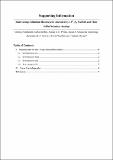Main group tellurium heterocycles anchored by a P2VN2 scaffold and their sulfur/selenium analogues
View/
Date
16/03/2015Author
Grant ID
EP/K503940/1
EP/K031252/1
EP/K039210/1
Metadata
Show full item recordAbstract
A comprehensive investigation of reactions of alkali-metal derivatives of the ditelluro dianion [TePV(NtBu)(μ-NtBu)]22– (L2–, E = Te) with p-block element halides produced a series of novel heterocycles incorporating P2VN2 rings, tellurium, and group 13–16 elements. The dianion engages in Te,Te′-chelation to the metal center in Ph2Ge and R2Sn (R = tBu, nBu, Ph) derivatives; similar behavior was noted for group 14 derivatives of L2– (E = S, Se). In the case of group 13 trihalides MCl3 (M = Ga, In), neutral spirocyclic complexes (L)M[NtBu(Te)PV(μ-NtBu)2PIIIN(H)tBu)] (M = Ga, In) comprised of a Te,Te′-chelated ligand L2– and a N,Te-bonded ligand resulting from loss of Te and monoprotonation were obtained. In reactions with RPCl2 (R = tBu, Ad, iPr2N) a significant difference was observed between Se- and S-containing systems. In the former case, Se,Se′-chelated derivatives were formed in high yields, whereas the N,S-chelated isomers predominated for sulfur. All complexes were characterized by multinuclear (1H, 31P, 77Se, 119Sn, and 125Te) NMR spectroscopy; this technique was especially useful in the analysis of the mixture of (L)(Se) and (L)(SeSe) obtained from the reaction of Se2Cl2 with L2– (E = Te). Single-crystal X-ray structures were obtained for the spirocyclic In complex (9), (L)GePh2 (E = Te, 10), (L)SntBu2 (E = Te, 12a); E = Se, 12aSe, E = S, 12aS) and (L)(μ-SeSe) (E = Te, 16).
Citation
Nordheider , A , Hüll , K , Prentis , J K D , Athukorala Arachchige , K S , Slawin , A M Z , Woollins , J D & Chivers , T 2015 , ' Main group tellurium heterocycles anchored by a P 2 V N 2 scaffold and their sulfur/selenium analogues ' , Inorganic Chemistry , vol. 54 , no. 6 , pp. 3043-3054 . https://doi.org/10.1021/acs.inorgchem.5b00161
Publication
Inorganic Chemistry
Status
Peer reviewed
ISSN
0020-1669Type
Journal article
Description
The authors are grateful to the EPSRC, the EPSRC National Mass Spectrometry Service Centre (NMSSC) Swansea, the School of Chemistry St. Andrews, EaStCHEM, and NSERC Canada for financial support.Collections
Items in the St Andrews Research Repository are protected by copyright, with all rights reserved, unless otherwise indicated.

